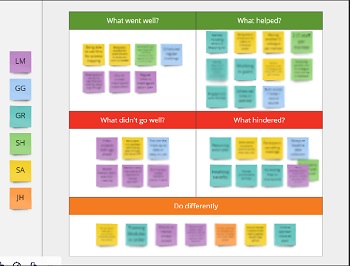The idea of an After-Action Review was first developed by the military and has found its way into common business project activities.
An After-Action Review is a great way to bring some closure at the end of a project as it gives the group involved a chance to reflect on how the project went and any lessons learnt and things, they would change going forward.
As part of the process, you need to organise a session for the team to come together to capture their input.
At the session there are 5 key questions that need to be answered, and the responses captured and summarised after an explanation from the group.
These questions should be written up on a flip chart if doing it physically in person, or on a digital white board if you are conducting the session virtually.

The first question to ask is:
What went well?
You need to give group the chance to input and share their thoughts about everything they felt was successful about the project and the benefits of doing it. Keep going until everyone has had a chance to input and their thoughts have been captured.
The second question to ask is:
What helped?
Again, go round the room and encourage people to share their thoughts. Capture the things that helped the project including methods, resources, and organisation.
The third question to ask is:
What didn’t go so well?
Encourage the group to be open and honest with their answers. Where possible, get participants to stick to facts and remind people that the whole point of doing this is to learn and move forward to approach things better in the future with consideration to the latest experience. Avoid any sense of blame and stick to processes rather than personalities.
The fourth question to ask is:
What hindered?
Ask the group about the barriers they came up against while carrying out the project and capture these once everyone has had a chance to input.
The fifth and final question is probably the most important part of the After-Action Review:
What would you do differently next time?
This is very much about identifying the lessons learned from the project and things the group should do differently going forward in the quest for Continuous Improvement.
The thoughts captured can be the basis for actions to be delivered when planning for the next project.
After-Action Reviews can also be a very helpful technique to discuss your own team activities on a weekly or monthly basis in the spirit of Continuous Improvement.
So next time you plan a project it would be a good idea to organise an After-Action Review session to be conducted towards the end of your project.
It is a great way to make sure the team are continuously improving and acting on the lessons learnt from every project.


